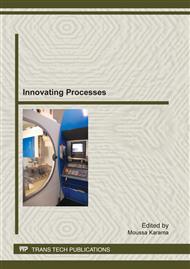[1]
J.C. Gelin. O. Ghouati. Une méthode d'identification inverse des paramètres matériels pour les comportements non-linéaires. Rev. Européenne des éléments Finis 4 (4) (1995) 463–485.
DOI: 10.1080/12506559.1995.10511193
Google Scholar
[2]
J.L. Chenot. E. Massoni. L. Fourment. Inverse problems in finite element simulation of metal forming processes. Engrg. Comput. 13 (2/3/4) (1996) 190–225.
DOI: 10.1108/02644409610114530
Google Scholar
[3]
J. -C. Gelin. O. Ghouati. An inverse solution procedure for material parameters identification in large plastic deformation. Commun. Numer. Methods Engrg. 12 (3) (1996) 161–173.
DOI: 10.1002/(sici)1099-0887(199603)12:3<161::aid-cnm961>3.0.co;2-e
Google Scholar
[4]
L. Fourment. J.L. Chenot. Inverse methods applied to metal forming processes. in: B.H.V. Topping (Ed. ). Computational Mechanics for theTwenty-First Century. Saxe-Coburg Publications. Edinburgh. 2000. p.127–143.
DOI: 10.4203/csets.3.7
Google Scholar
[5]
O. Ghouati. J. -C. Gelin. Identification of material parameters directly from metal forming processes. J. Mater. Process. Technol. 80–81 (1998) 560–564.
DOI: 10.1016/s0924-0136(98)00159-9
Google Scholar
[6]
J.P. Kleinermann. Identification paramétrique et optimisation des procèdes de mise a forme par problèmes inverses. Ph.D. thesis. Université de Liège. Septembre 2000. (In French).
Google Scholar
[7]
Nelder. J. -A. Mead. R. 1965. A simplex method for function minimization. Comput.J. 7. 308–313.
Google Scholar
[8]
A. Khalfallah. H. Bel Hadj Salah . A. Dogui Anisotropic parameter identification using inhomogeneous tensile test. European Journal of Mechanics A/Solids 21 (2002) 927–942.
DOI: 10.1016/s0997-7538(02)01246-9
Google Scholar
[9]
S. Comsa. G. Cosovici. P. Jurco. L. Paraianu. D. Banabic . Simulation of the hydroforming process using a new orthotropic yield criterion. Journal of Materials Processing Technology 157–158 (2004) 67–74.
DOI: 10.1016/j.jmatprotec.2004.09.018
Google Scholar
[10]
J.S. Chung. S.M. Hwang. Application of a genetic algorithm to process optimal design in non isothermal metal forming. J. Mater. Process. Technol. 80–81 (1998) 136–143.
DOI: 10.1016/s0924-0136(98)00209-x
Google Scholar
[11]
X.T. Feng. C. Yang. Genetic evolution of nonlinear material constitutive models. Comput. Methods Appl. Mech. Engrg. 190 (2001) 5957–5973.
DOI: 10.1016/s0045-7825(01)00207-9
Google Scholar
[12]
N. Huber. Ch. Tsakmakis. A neural network tool for identifying the material parameters of a finite deformation viscoplasticity model with static recovery. Comput. Methods Appl. Mech. Engrg. 191 (2001) 353–384.
DOI: 10.1016/s0045-7825(01)00278-x
Google Scholar
[13]
N. Chakraborti. Genetic algorithms in material design and processing. Int. Mater. Rev. 49 (3–4) (2004) 246–260.
Google Scholar
[14]
V.C. de Castilho. M. do Carmo Nicoletti. M.K. El Debs. An investigation of the use of three selection-based genetic algorithm families when minimizing the production cost of hollow core slabs. Comput. Methods Appl. Mech. Engrg. 194 (2005).
DOI: 10.1016/j.cma.2004.12.008
Google Scholar
[15]
M. Papadrakakis. N.D. Lagaros. Y. Tsompanakis. Structural optimization using evolution strategies and neural networks. Comput. Methods Appl. Mech. Engrg. 156 (1998) 309–333.
DOI: 10.1016/s0045-7825(97)00215-6
Google Scholar
[16]
S.F. Masri. A.W. Smyth. A.G. Chassiakos. M. Nakamura. T.K. Caughey. Training neural networks by adaptive random search techniques. J. Engrg. Mech. – ASCE 125 (1999) 123–132.
DOI: 10.1061/(asce)0733-9399(1999)125:2(123)
Google Scholar
[17]
Q.S. Li. D.K. Liu. A.Y.T. Leung. N. Zhang. C.M. Tam. L.F. Yang. Modelling of structural response and optimization of structural control system using neural network and genetic algorithm. Struct. Design Tall Buildings 9 (2000) 279–293.
DOI: 10.1002/1099-1794(200009)9:4<279::aid-tal152>3.0.co;2-2
Google Scholar
[18]
M. Papadrakakis. N.D. Lagaros. Reliability based structural optimization using neural networks and Monte Carlo simulation structural optimization using evolution strategies and neural networks. Comput. Methods Appl. Mech. Engrg. 191 (32) (2002).
DOI: 10.1016/s0045-7825(02)00287-6
Google Scholar
[19]
A. Delameziere. H. Naceur. P. Breitkopf. C. Knopf-Lenoir. P. Batoz. J. -L. Villon. Feasibility in deep drawing: optimization of material properties using response surface. Mec. Ind. 3 (2002) 93–98.
Google Scholar
[20]
R. Myers. D. Montgomery. Response Surface Methodology: Process and Product Optimization Using Designed Experiments. second ed. Wiley. New York. USA. 2002 ISBN 0-471-41255-4.
Google Scholar
[21]
P. Breitkopf. H. Naceur. A. Rassineux. P. Villon. Optimizing metal forming processes using response surface approximation and inverse approach surrogate model. in: Proceedings of ESAFORM. Trondheim. Norway. (2004).
Google Scholar
[22]
H. Naceur. Y.Q. Guo. S. Ben-Elechi Response surface methodology for design of sheet forming parameters to control springback effects. Computers and Structures 84 (2006) 1651–1663.
DOI: 10.1016/j.compstruc.2006.04.005
Google Scholar
[23]
M. Ayadi. M. A Rezgui . A. Cherouat. F. Slimani et T. M. Nasri. Contribution à la modélisation Expérimentale et Numérique des Instabilités Plastiques en Hydroformage des Tôles Minces. Mécanique & Industries Vol. 10 (2009) pp : 503-519.
DOI: 10.1051/meca/2010009
Google Scholar


